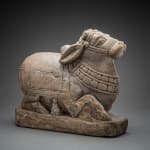Stone figure representing the Indian bull Nandi, 12th Century CE - 13th Century CE
Stone
25 x 27.9 cm
9 7/8 x 11 in
9 7/8 x 11 in
FF.101
Further images
Nandi is the name of the gate-guardian deity of Kailasa, the abode of Lord Shiva. The deity is usually depicted as a bull that also serves as mount to the...
Nandi is the name of the gate-guardian deity of Kailasa, the abode of Lord Shiva. The deity is usually depicted as a bull that also serves as mount to the god Shiva. Regularly honoured by worshippers with offerings of flowers and incense, sculptures of Nandi are often touched in the hope that devotees will be able to acquire the strength of his devotion to Shiva.
The word "Nandi" derives from Tamil root word Nandhu which means to grow, to flourish.
The Sanskrit word "Nandi"has the meaning of "happiness", "joyfulness" and "he who gives joy and satisfaction", referring to the emotions experienced by devotees in the presence of Shiva.
Almost all Shiva temples display stone images of a crouching Nandi, generally facing the main shrine.
The scale of this example suggests it was used for private devotion, or possibly donated to a temple as a votive offering. As Shiva’s most devoted disciple, his image is often placed directly opposite Shiva’s shrine in Hindu temples. It is not known when these two deities first came to be associated but there is a long history of devotion to bulls in Asia. The early civilisation of the Indus Valley in particular (c. 3000-2000 BC) clearly held the bull in high veneration- producing images in stone and terracotta. In Sanskrit Nandi means ‘joyfulness’ or ‘He who gives joy.’ This refers to the emotions experienced by the devotee in the presence of Shiva.
The scale of this example suggests it was used for private devotion, or possibly donated to a temple as a votive offering. Dating from the twelfth-thirteenth centuries, the sculpture is in remarkably good condition, with minor losses from the nose, horns and base. Traces of red pigment survive on the surface suggesting it was once fully polychromed. The bull is recumbent with his front legs stretched out in front of him in a pose of adoration (presumably towards Shiva). A simple rectangular rug covers his back and a double-string of rectangular beads hangs impressively around his neck. A harness has been placed around his slightly upturned head, which bears a wonderfully benign and peaceful expression. The ears are long but the horns are barely out. This is in accordance with Nandi iconography which refers to him as a calf. The slender tail is tucked gracefully between his back legs. This work is remarkable, both for the quality of the carving and its early date.
The word "Nandi" derives from Tamil root word Nandhu which means to grow, to flourish.
The Sanskrit word "Nandi"has the meaning of "happiness", "joyfulness" and "he who gives joy and satisfaction", referring to the emotions experienced by devotees in the presence of Shiva.
Almost all Shiva temples display stone images of a crouching Nandi, generally facing the main shrine.
The scale of this example suggests it was used for private devotion, or possibly donated to a temple as a votive offering. As Shiva’s most devoted disciple, his image is often placed directly opposite Shiva’s shrine in Hindu temples. It is not known when these two deities first came to be associated but there is a long history of devotion to bulls in Asia. The early civilisation of the Indus Valley in particular (c. 3000-2000 BC) clearly held the bull in high veneration- producing images in stone and terracotta. In Sanskrit Nandi means ‘joyfulness’ or ‘He who gives joy.’ This refers to the emotions experienced by the devotee in the presence of Shiva.
The scale of this example suggests it was used for private devotion, or possibly donated to a temple as a votive offering. Dating from the twelfth-thirteenth centuries, the sculpture is in remarkably good condition, with minor losses from the nose, horns and base. Traces of red pigment survive on the surface suggesting it was once fully polychromed. The bull is recumbent with his front legs stretched out in front of him in a pose of adoration (presumably towards Shiva). A simple rectangular rug covers his back and a double-string of rectangular beads hangs impressively around his neck. A harness has been placed around his slightly upturned head, which bears a wonderfully benign and peaceful expression. The ears are long but the horns are barely out. This is in accordance with Nandi iconography which refers to him as a calf. The slender tail is tucked gracefully between his back legs. This work is remarkable, both for the quality of the carving and its early date.





